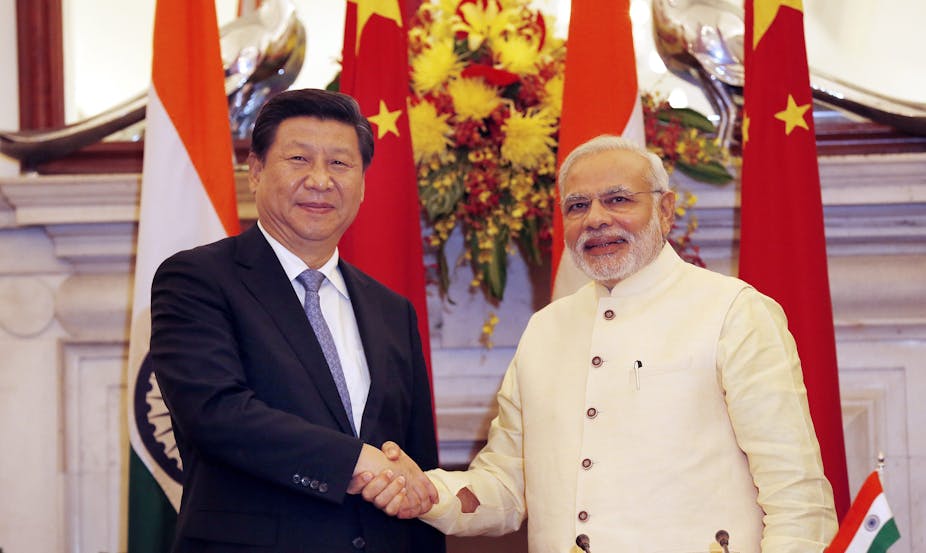At the UN Climate Negotiations underway in Lima, Peru, foreign minister Julie Bishop has called on China and India to do more to reduce greenhouse gas emissions.
In her address to the conference on Wednesday local time, Bishop suggested that the long-standing distinction between developed and developing countries “is misleading and doesn’t lead to best outcomes”, implying that China and India, two of the largest emitters of greenhouse gases, shouldn’t be able to rely on their developing country status to avoid deep commitments to reduce emissions.
This position is understandable if you focus on current and future emissions patterns. According to a recent Intergovernmental Panel on Climate Change (IPCC) report (see page 131), in 2010 China contributed 26% of global emissions, while India was responsible for 6.6%.
Most of the future growth in emissions is expected to come from large developing countries. Addressing climate change will therefore require large developing countries to play a leading role in global efforts to reduce emissions.
Sparing developing nations
The 1992 United Nations Framework Convention on Climate Change (UNFCCC) is the overarching treaty under which these annual climate negotiations are conducted. The distinction between developed and developing countries is a key feature of the UNFCCC.
A deliberate choice was made in 1992 to spare developing countries the initial burden of leading the global response to reduce emissions. This choice was justified on grounds of fairness.
The UNFCCC recognised that developed countries should take the first steps to combat climate change, as they had largely caused the problem and had more capacity to quickly reduce emissions.
The UNFCCC provided that roughly 35 developed countries (including Australia) would go first in reducing emissions, with the other 160-odd developing countries (including China and India) coming on board at a later time.
Similarly, the 1997 Kyoto Protocol only imposed binding emission reduction targets on developed countries. As a developed country, Australia negotiated to limit its greenhouse gas emissions to 8% above 1990 levels by 2012. This proved to be a relatively soft target compared with other developed countries.
Developing countries, such as China and India, were not required to commit to binding targets at that time. Since the 2009 Copenhagen Accord, emission reduction targets in the UN climate negotiations are merely voluntary. Australia agreed to reduce its emissions by 5% to 25% below 2000 levels by 2020.
Interestingly, China and India volunteered less ambitious emission reductions by 2020.
Fair call
The key issue of fairness between developed and developing countries has been largely sidelined since 2009.
However, the issue of fairness is again hotting up as countries look towards critical UN climate negotiations in 2015. The hope is that an ambitious global agreement will be reached in Paris, and will contain fair emission reduction targets for all countries to take effect from 2020.
The key to the Paris negotiations lies in agreeing, for the first time, on binding emission reduction commitments for major developing countries. Minister Bishop is right to point out that this issue is critically important.
However, it is essential that developed countries (such as Australia) don’t lose sight of the fairness principles embedded in the UNFCCC. Simply telling developing countries to “do more” on emission reduction is unlikely to have the desired effect.
The key is to draw major developing countries (such as China and India) into ambitious and binding commitments without losing sight of the fairness principles that have informed the negotiations for more than 20 years.
Developed, developing, and…
One possible solution that has been mooted is to create an intermediate category of countries (including China and India) sitting between developed and developing countries in future negotiations. Countries in this category would have binding emission reduction commitments that reflect changes in their position since 1992.
This is a sensible way to move global climate negotiations forward while still accommodating the fairness principles that underpin the UNFCCC. The recent climate agreement between the US and China shows that major developing countries are open to this possibility.
However, commitments of countries in this category will not be as strong as those of the developed countries. This approach may preserve the fairness principle underlying the UNFCCC that is held dear by major developing countries.
Fairness has underpinned UN climate negotiations since 1992 and remains crucial as the world resets its emission reduction targets to deal with climate change.
Developed countries must respect the fairness principle underlying the UNFCCC if there is to be a breakthrough with major developing countries on emission reduction commitments. The world needs this now to avoid dangerous climate change.

